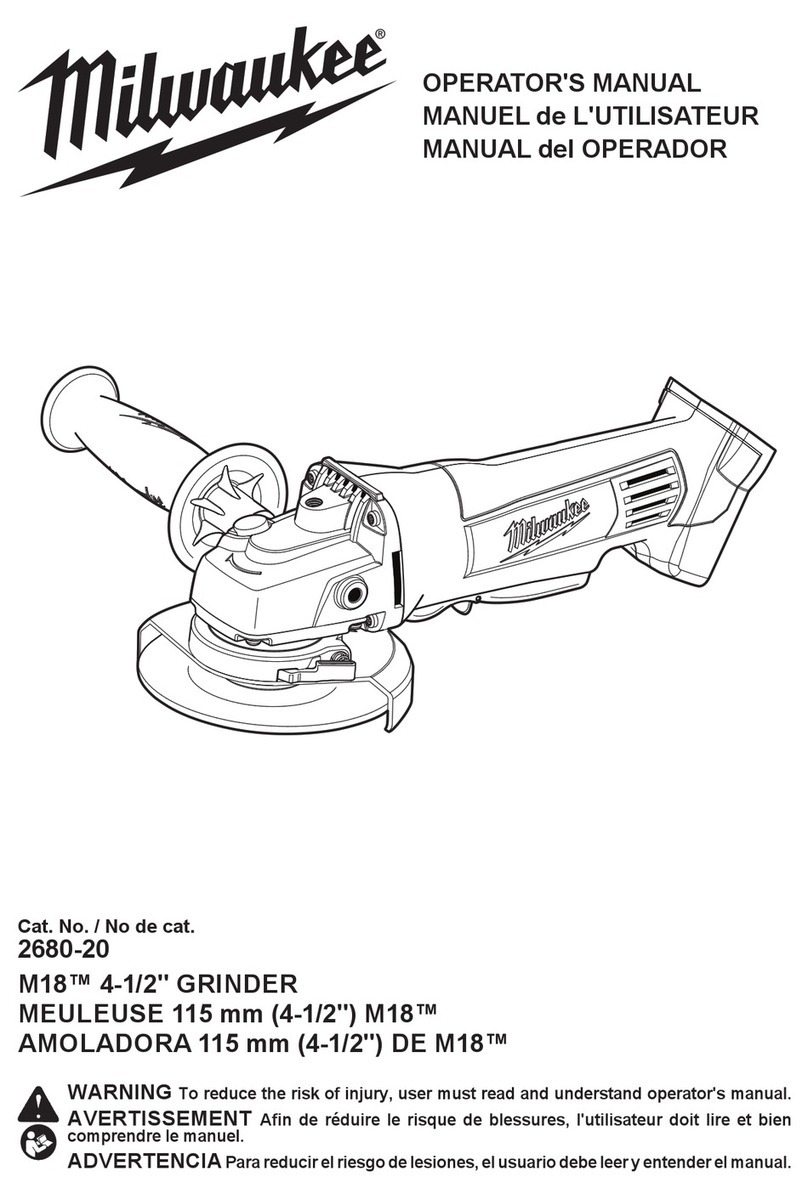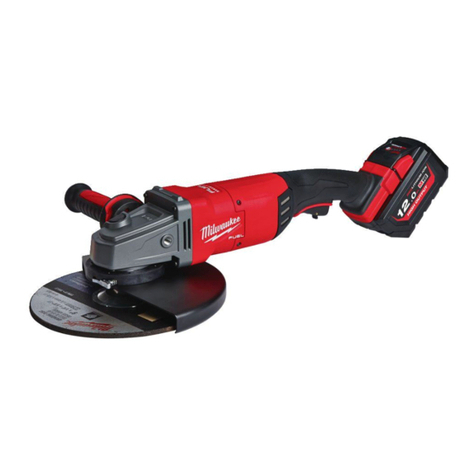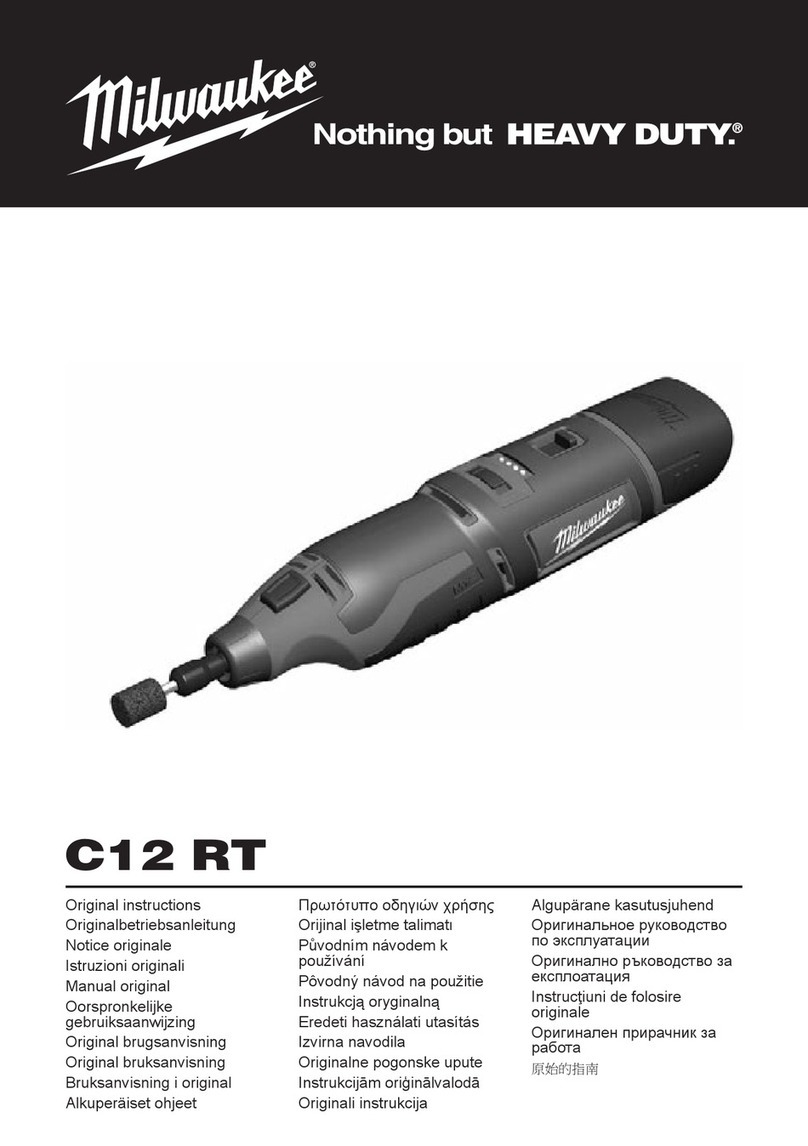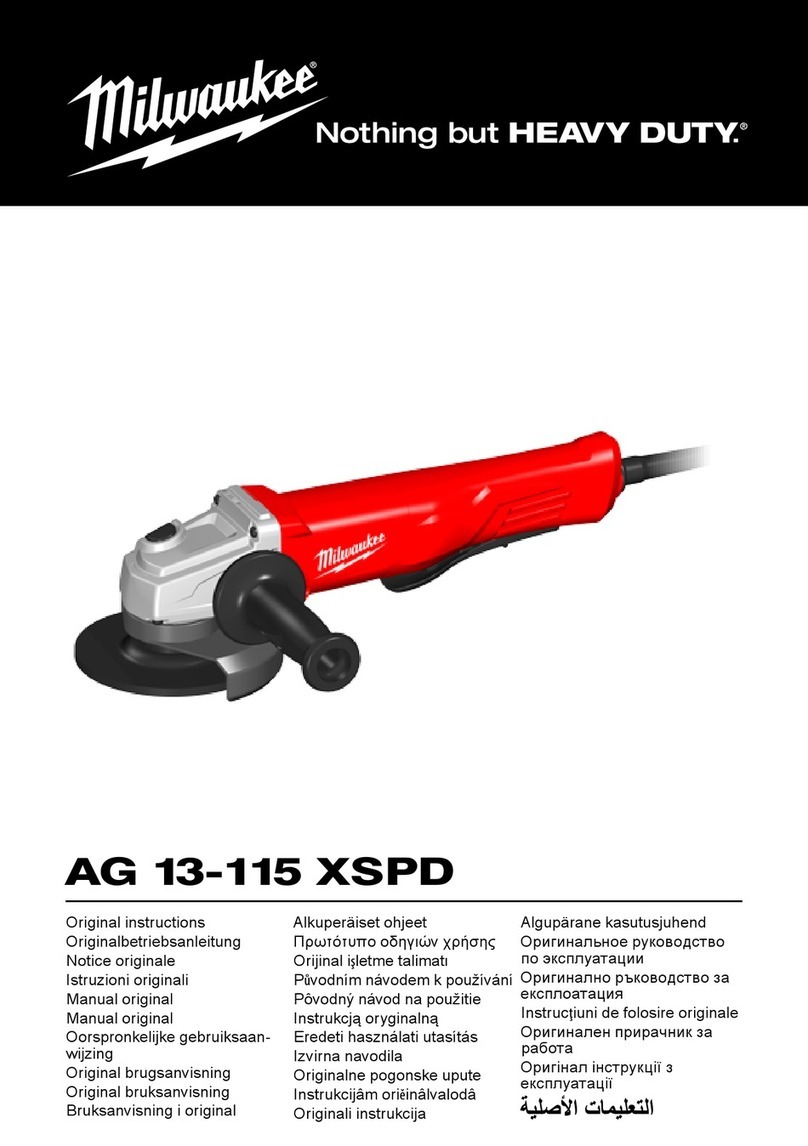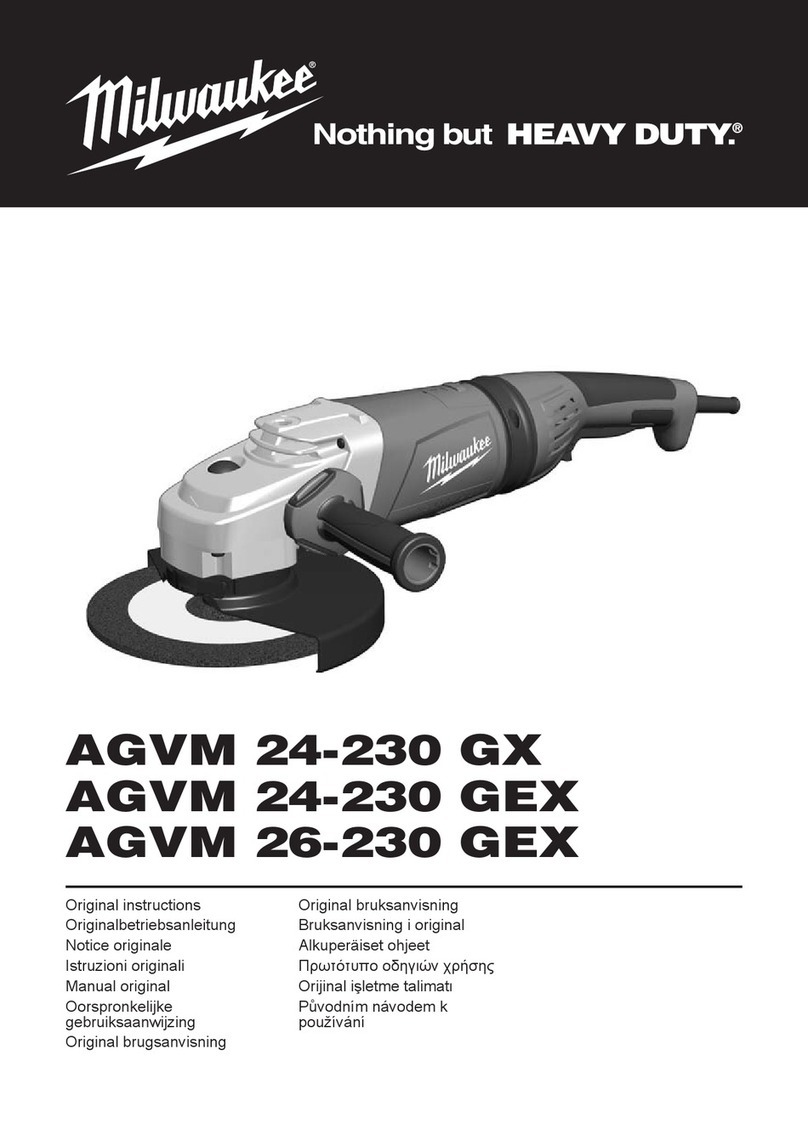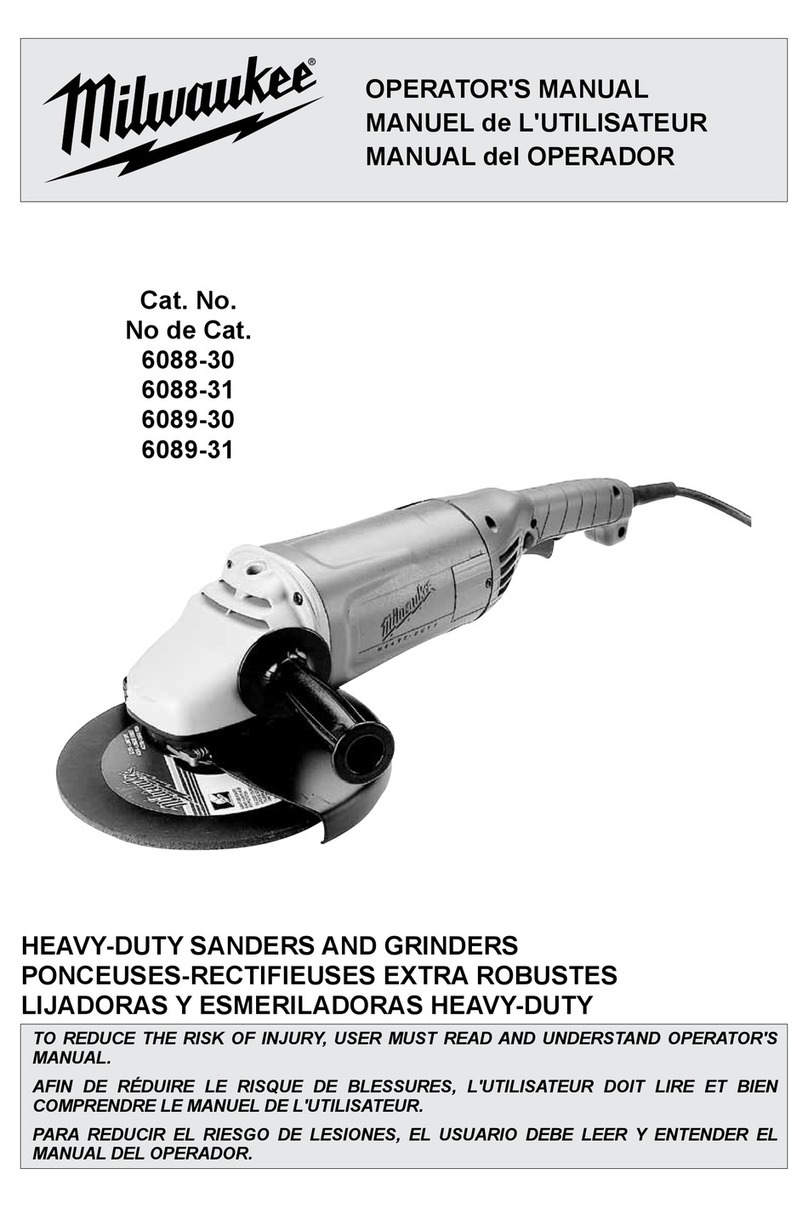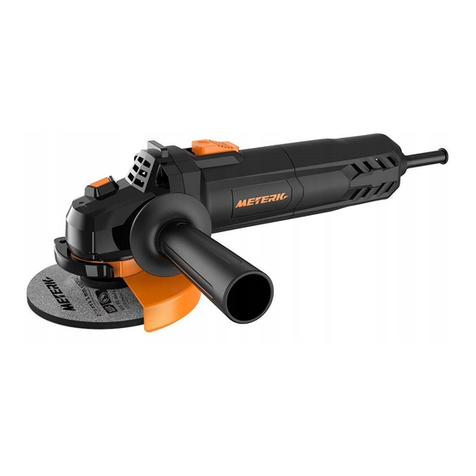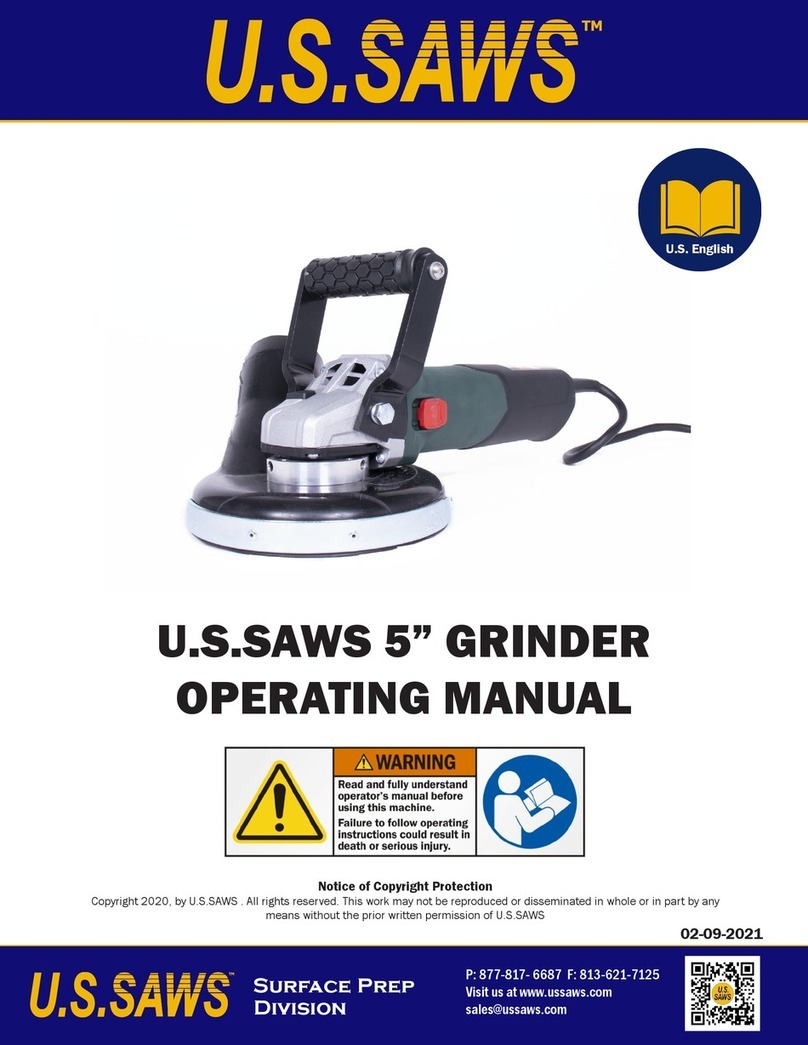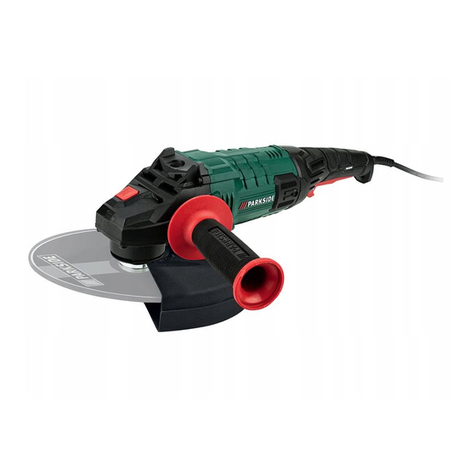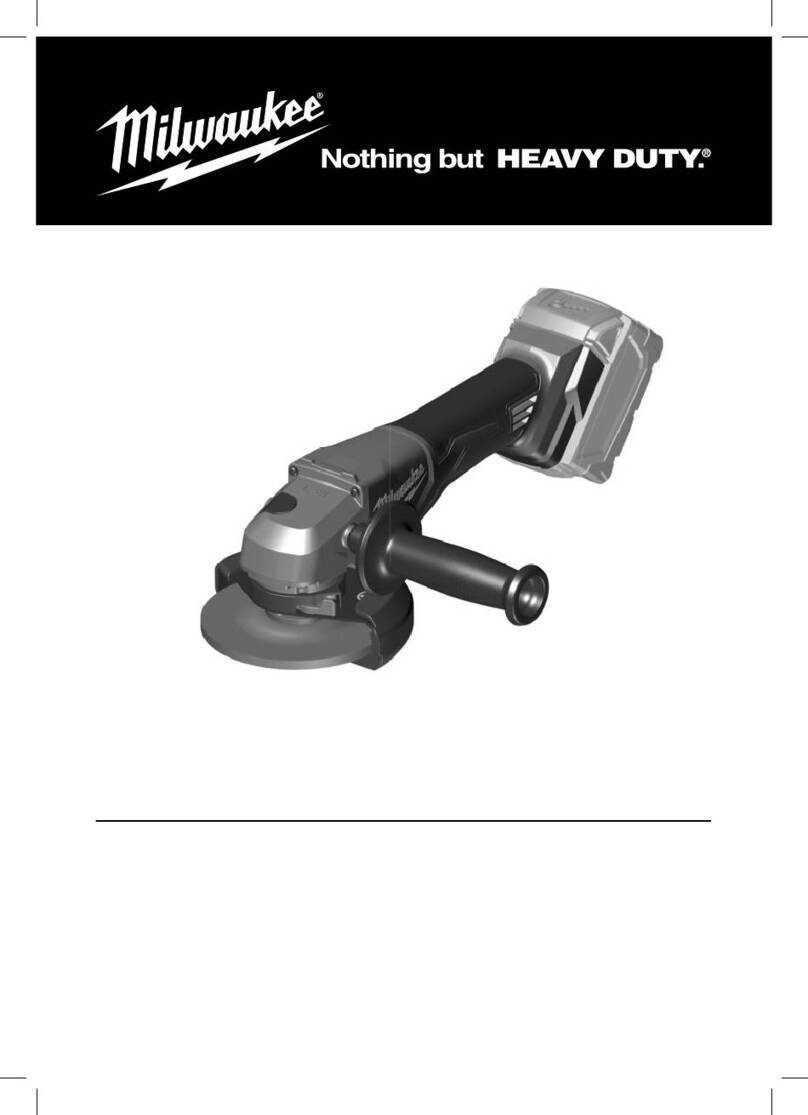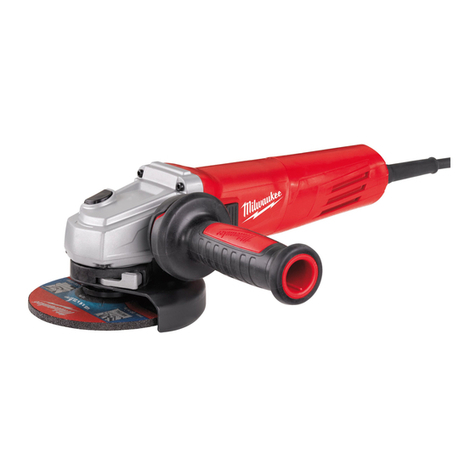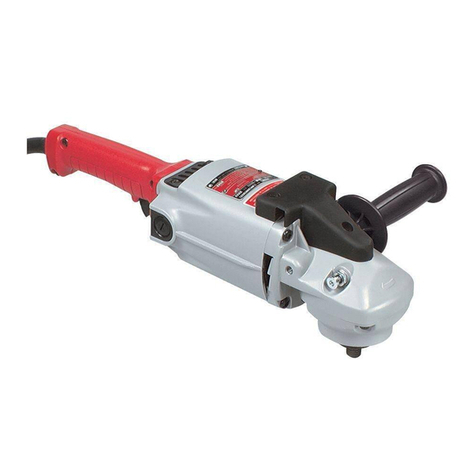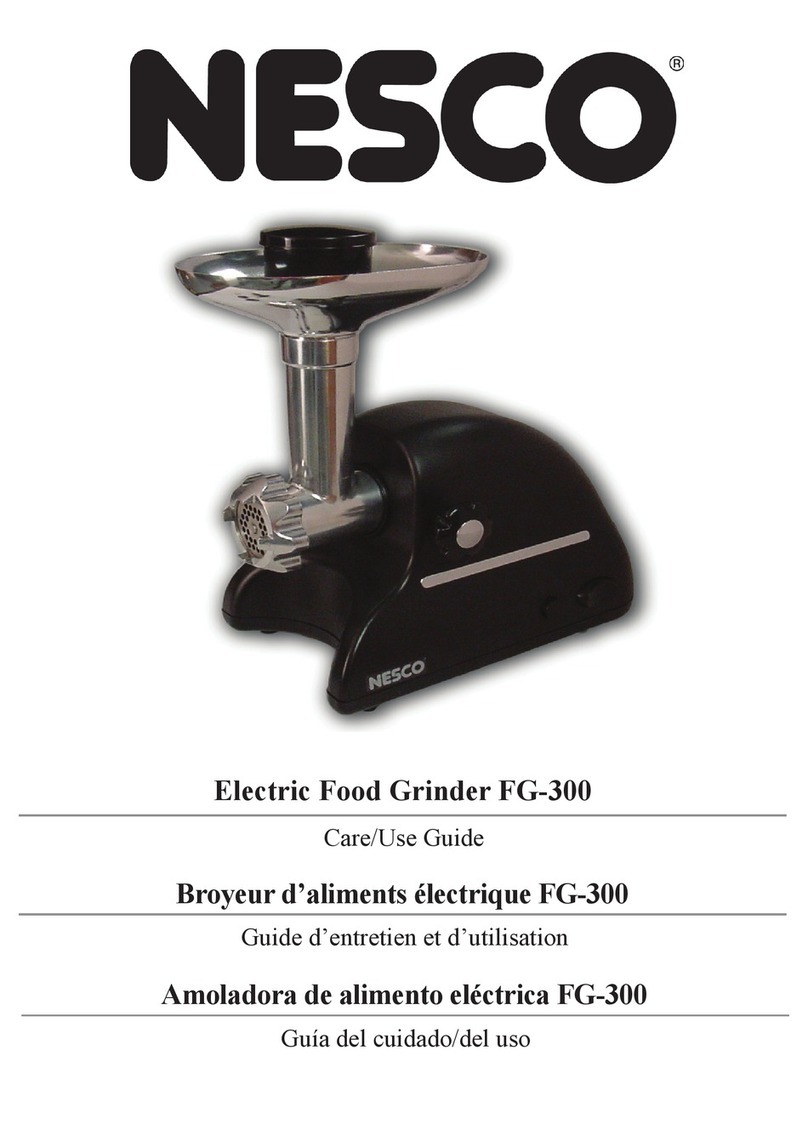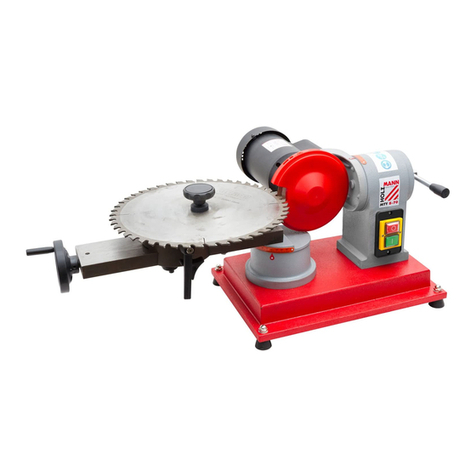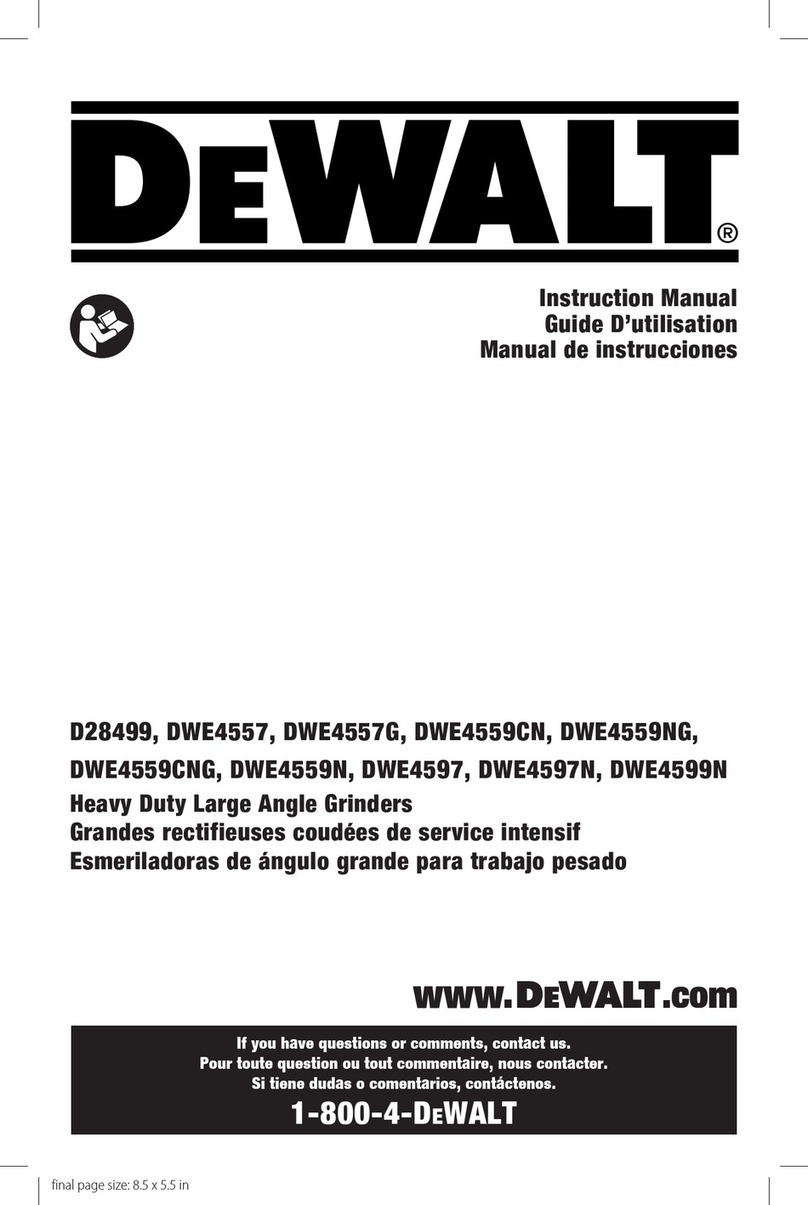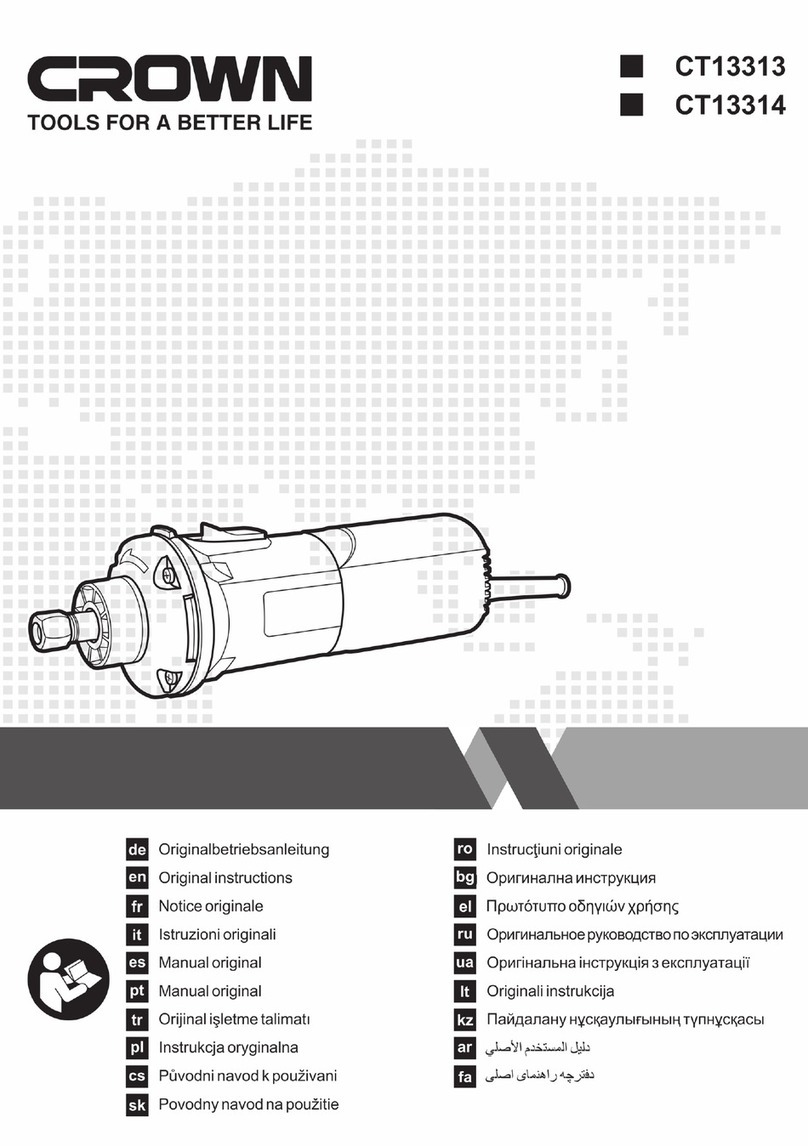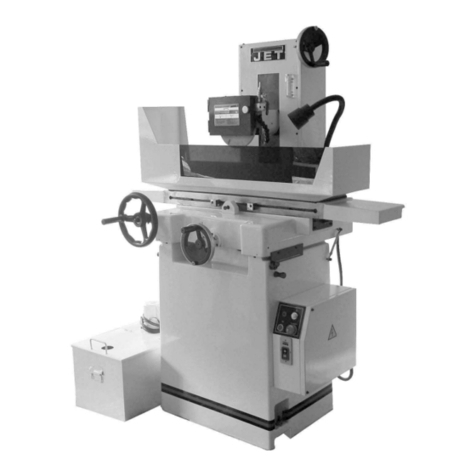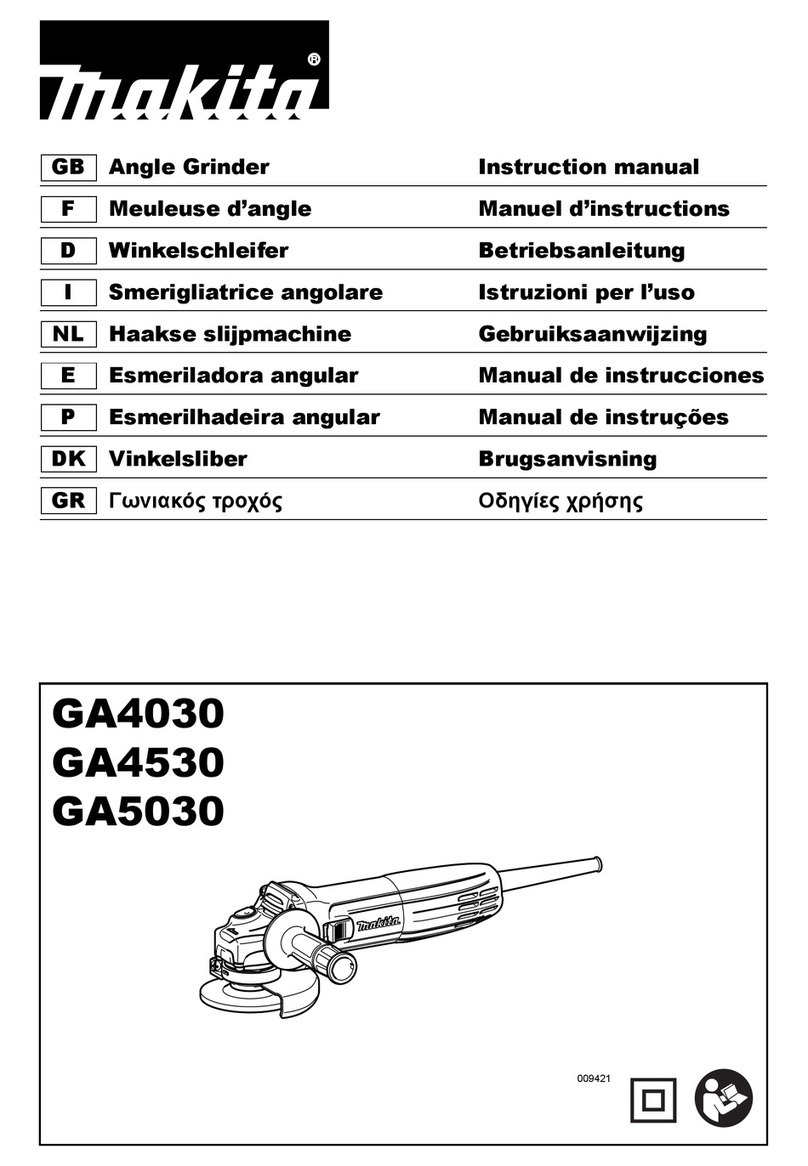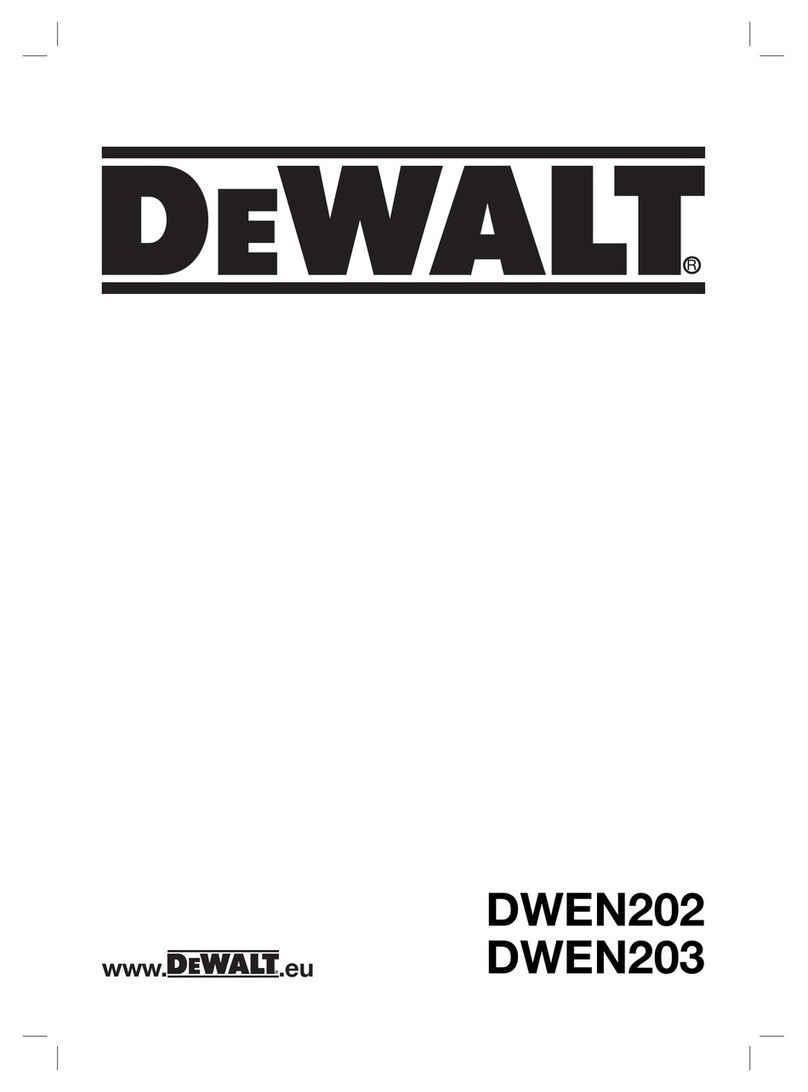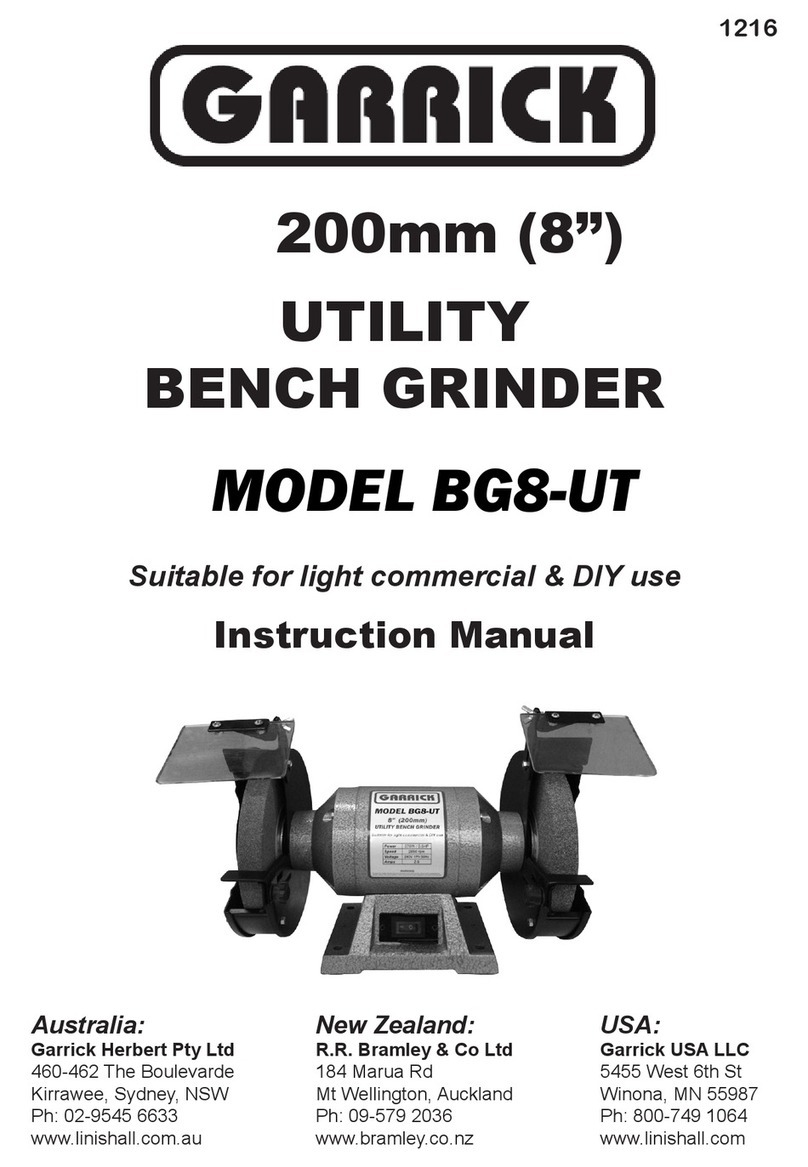14 15
•S’assurer que personne ne se tient à proximité
du lieu de travail. Toute personne qui entre sur
le lieu de travail doit porter l’équipement de
protectionrequis. Desfragments provenantde la
pièce à travailler ou d’un accessoire brisé peuvent
êtreprojetés etcauser desblessures,même àdes
personnessetenantàune certainedistancedulieu
de travail immédiat.
•Tenir l’outil par ses surfaces de préhension
isolées lors des opérations pendantlesquelles
l’accessoire de coupe peut entrer en contact
avec du câblage caché ou avec son propre
cordond’alimentation. Lecontactavec unfilsous
tension « électrifie » les pièces métalliques expo-
sées de l’outil et peut électrocuter l’utilisateur.
•Tenir le cordon loin de l’accessoire en rota-
tion. En cas de perte de contrôle, le cordon peut
être coupé ou accroché, et la main ou le bras
de l’utilisateur risquent d’entrer en contact avec
l’accessoire en rotation.
• Nejamais déposer l’outil électrique avantl’arrêt
completde l’accessoire.L’accessoireenrotation
peutaccrocher lasurface etoccasionner uneperte
de contrôle.
•Ne jamais laisser l’outil électrique fonctionner
en le transportant à ses côtés. L’accessoire en
rotation peut s’accrocher accidentellement aux
vêtements et entrer en contact avec l’utilisateur.
•Nettoyer régulièrement les évents d’aération
de l’outil électrique. Le ventilateur du moteur
aspire la poussière dans le logement et crée une
accumulationexcessive demétalfritté, cequi peut
causer un risque électrique.
•Nepas fairefonctionnerl’outil électriqueàprox-
imité de matériaux inflammables. Les étincelles
peuvent enflammer ces matériaux.
•Ne pas utiliser d’accessoires qui nécessitent
desliquide derefroidissement. L’utilisationd’eau
ou d’un autre liquide de refroidissement peut en-
traîner une électrocution ou un choc électrique.
REBONDS ET AVERTISSE-MENTS CONNEXES
Un rebond est une réaction soudaine attribuable au
pincementouàl’accrochagede lameule,duplateau
porte-disque, de la brosse ou de tout autre acces-
soire en rotation. Un pincement ou un accrochage
provoque le blocage immédiat de l’accessoire en
rotation qui, à son tour, entraîne l’outil incontrôlé
dans le sens opposé à la rotation de l’accessoire, à
l’endroit du coincement.
Par exemple, si une meule abrasive est accrochée
ou pincée par la pièce à travailler, le rebord de la
meule qui entre dans le point de pincement peut
s’enfoncer dans la surface du matériau, éjectant la
meule de la pièce à travailler ou la faisant rebondir,
versl’utilisateur ouloin de lui,selon lesens dumou-
vement de la meule au point de pincement. Dans
ces conditions d’utilisation, les meules abrasives
peuvent également se briser.
Unrebond estattribuable àune mauvaiseutilisation
de l’outil ou au non-respect des procédures ou des
conditionsd’utilisation. Pourempêcher lesrebonds,
respecter les directives décrites ci dessous.
•Tenir fermement l’outil électrique et placer le
corps etles mainsde manièreà pouvoirrésister
auxrebonds. Toujours utiliserla poignéeauxili-
aire, s’il y en a une, pour assurer un contrôle
optimal en cas de rebond ou de réaction de
couple lors du démarrage de l’outil. L’utilisateur
peut contrôler les rebonds et les réactions de
couple s’il respecte les directives prescrites.
•Ne jamais placer les mains à proximité de
l’accessoire en rotation. En cas de rebond,
l’accessoire peut dévier sur celles ci.
•Ne pas positionner le corps à l’endroit où
sera entraîné l’outil électrique si un rebond se
produit. Un rebond entraînera l’outil dans le sens
opposé au mouvement de la meule, à l’endroit de
l’accrochage.
•Faire preuve d’une extrême prudence au mo-
ment d’utiliser l’outil sur des coins ou des
rebords tranchants. Les coins, les rebords tran-
chantsetlessurfacesrebondissantes onttendance
às’accrocher àla pièceen rotationet àcauserune
perte de contrôle ou des rebonds.
•Ne pas fixer une lame de sculpteur pour scie à
chaîne ou une lame de scie dentée. Ces deux
typesde lameoccasionnent denombreux rebonds
et des pertes de contrôle fréquentes.
Règles de sécurité particulières pour Meulage
et tronçonnage à la meule :
•Utiliser seulement les types de meule recom-
mandés pour cet outil électrique et le protège
disque spécialement conçu pour la meule
utilisée. Il est impossible de protéger de façon
adéquateles meulesqui nesont passpécialement
conçues pour l’outil électrique. De plus, elles ne
sont pas sécuritaires.
•Le protège disque doit être fixé solidement à
l’outil électrique et positionné de manière à
garantir une sécurité optimale; il importe donc
de diriger le moins possible la meule vers
l’utilisateur. Le protège disque aide à protéger
l’utilisateur des fragments qui peuvent se dé-
tacher de la meule et du contact accidentel avec
la meule.
• Utiliserseulement les meules poureffectuer des
opérations pour lesquelles elles sont conçues.
Par exemple, ne pas meuler avec le côté d’une
meule à tronçonner. Les meules à tronçonner
abrasives doivent être utilisées pour la rectification
périphérique. Le fait d’appliquer une force latérale
sur les meules peut provoquer leur bris.
•Toujours utiliser des brides de meules non
endommagées de formes et de dimensions
convenables. Les brides de meules adéquates
soutiennent la meule, ce qui minimise les risques
de bris de la meule. Les brides des meules à
tronçonner peuvent différer des brides de meules
standards.
•Ne pas utiliser de meules usées qui provien-
nent d’outils électriques de plus grandes
dimensions. Les meules conçues pour des outils
électriques de plus grandes dimensions ne convi-
ennent pas à la vitesse plus élevée des outils de
plus petite dimension et peuvent éclater.
Règles de sécurité particulières pour Tronçon-
nage à la meule :
•S’assurer que la meule à tronçonner ne se
coince pas et éviter d’appliquer trop de pres-
sion. Ne pas régler la meule à une profondeur
de coupe excessive. Le fait d’appliquer trop de
pression sur la meule augmente la charge, la
tendance de la meule à se tordre ou à se coincer
pendant la coupe, ainsi que les risques de rebond
ou de bris de la meule.
•Ne pas setenir vis-à-vis de lameule en rotation
ou derrière celle-ci. Pendant l’opération, lorsque
la meule s’éloigne de l’utilisateur, un rebond pou-
vantprojeter lameuleenrotationet l’outilélectrique
directement vers l’utilisateur peut se produire.
•Si la meulese coince ousi l’opérationde coupe
est interrompue pour une raison quelconque,
éteindre l’outil électrique et le maintenir im-
mobile jusqu’à ce que la meule s’arrête com-
plètement. Ne jamais tenter de retirer la meule
à tronçonnerlorsque celle-ciest enmouvement
afin d’éviter qu’un rebond ne se produise.
Examiner la situation et trouver une solution qui
permettra d’éviter que la meule ne se coince.
•Ne pas remettre en marche l’outil si celui-ci est
dans la pièce à travailler. Permettre à la meule
d’atteindre sa vitesse maximale puis la réin-
sérer dans le trait de coupe avec précaution.
La meule risque de se coincer, de se soulever ou
de rebondir si cette précaution n’est pas prise.
•Soutenir les panneaux ainsi que toute pièce à
travailler surdimensionnée afin de minimiser
les risques de pincement de la meule et de
rebond. Les pièces à travailler de grandes dimen-
sionsont tendanceà fléchirsousleurproprepoids.
Il importe donc de disposer des supports sous la
pièce à travailler, près du trait de coupe ainsi que
du rebord de la pièce à travailler, des deux côtés
de la meule.
•Ne pas utiliser desaccessoires qui nesont pas
spécialement conçus pour lemodèle d’outil ou
qui ne sont pas recommandés par le fabricant.
Le simple fait qu’un accessoire peut s’ajuster sur
l’outilélectrique nesignifie pasqu’il peutêtre utilisé
en toute sécurité.
•La vitesse nominale de l’accessoire doit au
moins être égaleà la vitesse maximale indiquée
sur l’outil électrique. Les accessoires qui sont
utilisés à une vitesse supérieure à leur vitesse
nominale peuvent se briser et se détacher.
•Le diamètre extérieur et l’épaisseur de
l’accessoire doivent être conformes à la ca-
pacité de l’outil électrique. Il est impossible de
protéger ou de contrôler adéquatement un acces-
soire de dimension inappropriée.
•La taille de l’arbre des meules, des brides, des
plateaux porte-disque ou de tout autre acces-
soire doit convenir parfaitement à la broche de
l’outil électrique. Si les accessoires utilisés sont
dotés d’alésages centraux qui neconviennent pas
à la pièce de montage de l’outil, ils se déstabili-
seront, vibreront de façon excessive et pourront
causer une perte de contrôle.
•Ne pas utiliser un accessoire endommagé.
Inspecter l’accessoire avant chaqueutilisation
afin de s’assurer que les meules, par exemple,
sontexemptes d’ébréchureset de fissures,que
le plateau porte-disque est exempt de fissures
et qu’il n’est pas usé de façon excessive, et
que la brosse métallique ne comprend pas de
fils détachés ou craquelés. Si l’outil électrique
ou l’accessoire est échappé, s’assurer qu’il
n’est pas endommagé ou installer un autre ac-
cessoire. Après avoir effectué cette opération,
se tenir à distance de l’accessoire en rotation
et faire fonctionner l’outil à sa vitesse à vide
maximale pendant une minute. S’assurer que
personne ne se tient à proximité de l’outil. Les
accessoiresendommagéssebrisentgénéralement
lors de cette vérification.
•Porter de l’équipementde protection dequalité
professionnelle.Selon letype d’opération,por-
ter un masque de protection ou des lunettes
de sécurité. Au besoin, porter également
un masque anti-poussières, un protecteur
d’oreille, des gants et un tablier d’atelier ré-
sistant aux petits fragments abrasifs ou aux
fragments provenant des pièces à travailler. La
protection oculaire utilisée doit résister aux débris
projetéslors desdifférentesopérations.Lemasque
anti-poussières et le masque filtrant doivent filtrer
les particules produites lors de l’opération. Une
exposition prolongée à un bruit fort peut entraîner
une perte auditive.



